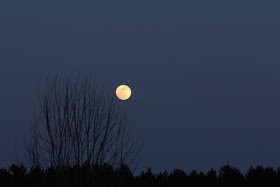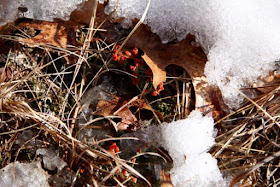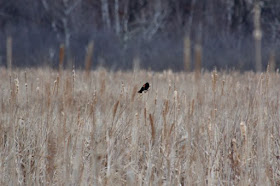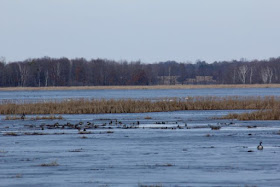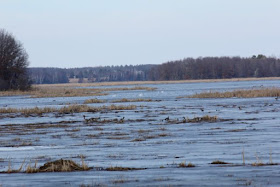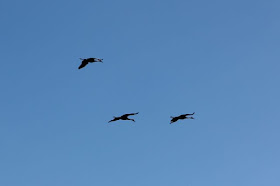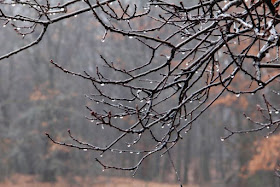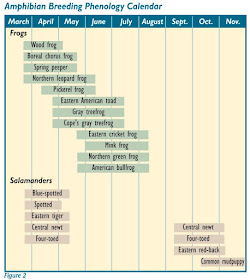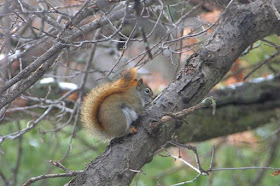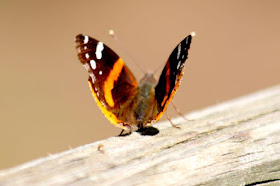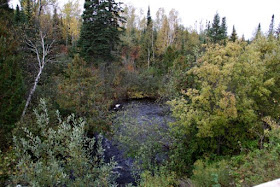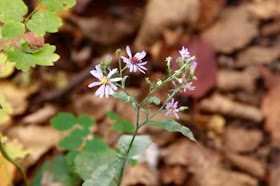Against a prematurely Spring-gray sky, three tundra swans appeared over the tree line and flew across the back field. My morning was made. We've had many Canada geese follow a similar pattern, but this is the first time in going on twenty-five years that swans have honored us locally with their presence. I certainly hope we can be accommodating and hospitable with our weather. Much depends on the track of the storm forecast for later this week and the duration of below freezing weather.
The very early warmup we've been having this year has made me think more about seasons, climate change and bioregional patterns.
Evidence thus far indicates Minnesota's seasons are shifting to earlier ice out, longer growing seasons, earlier ends to snow season and a variety of other changes to what had been historical events and patterns. Are those the correct
initial conditions against which to measure change?
 |
late May apple blossoms
|
Much of this would have seemed to be of limited, but largely beneficial, relevance to me when I was commuting to an office job in St. Paul. Fewer commutes due to less snow? Great! More allergies? More decongestants! If late frosts took out Minnesota's
honeycrisp apple crop one year, we'd just eat something from Michigan that year. No problem, unless there are no pollinators available because we've done most of them in with pesticides.
This year, I've started fretting about what happens if the entire ephemeral wild flower season is lost (no photographs) or, more significantly, what if the changing seasonal patterns take out almost all the locally grown vegetables for one year? We'd still be able to live but have less joy in living. No local veggies, get them from California? What if California's droughted or washed out?
Then, early this morning, I read about Gary Snyder's yearly cycle, as he described it in a 1973 interview with New York Quarterly:
"...in the spring I go out to the desert for awhile, and I give a few readings, and then when I get back it's time to turn the ground over and start spring planting, and then right after that's done it's time to do the building that has to be done, and then when that's done, it's time to start cutting firewood, and then when the firewood's done, it's just about time to start picking apples and drying them, and that takes a couple of weeks to get as many apples as possible and dry them, and then at the end of apple season I begin to harvest the garden, and a lot of canning and drying is done maybe, and then when that season passes, to chestnuts and picking up the wild grapes, and then I've got to put the firewood in, and as soon as I get thee firewood in, hunting season starts —and that winds up about the end of October with Halloween festivities, and then I go East for a month to read. So December, January and February is my time of total isolation, writing:..."
 |
trout lilies, early May ephemerals
|
As I compared Snyder's yearly cycle of activities, and their variety and pattern, and thought about how many are central to his life (food and warmth shelter and and cash income), I began to realize why something like climate change might present a more obvious, not more significant but more obvious, challenge to someone like Snyder than to a 9-to-5 office worker (like me in a former life, like you these days?) who hunts, fishes, gardens and forages as nonessential hobbies. And then there's the significant problems related to growing and transporting food, such as drought and floods and potential dam failures in California. Similar problems are starting to occur and recur throughout the rest of the country and the world. Then, in the US, we've compounding our production and transport problems by cutting off most or all of the labor supply on which we've relied historically to harvest our crops. If we were trying to get a gold medal for dumb, we'd be doing just about exactly what we're doing now.
Reading Snyder's cycle also helped me to realize just how cut off from reality most of us are. We depend more than we realize or admit on nature's abundant resources, and also on each other and our collective, coordinated ability to time and synchronize our activities with each other and natural cycles. As my mother used to point out to me after I'd done something dumb, "It might behoove me to modify my behavior in the future." We're compounding problems created by changes in the historic, natural cycles we're currently disrupting by electing people who deny that such changes are occurring and while also claiming the well-documented patterns are a "hoax." I hope you'll take some time to think about these topics before the next time you cast a ballot.
I ain’t gonna work on Maggie’s farm no more
No, I ain’t gonna work on Maggie’s farm no more
Well, I wake in the morning
Fold my hands and pray for rain
I got a head full of ideas
That are drivin’ me insane
It’s a shame the way she makes me scrub the floor
I ain’t gonna work on Maggie’s farm no more
I ain’t gonna work for Maggie’s brother no more
No, I ain’t gonna work for Maggie’s brother no more
Well, he hands you a nickel
He hands you a dime
He asks you with a grin
If you’re havin’ a good time
Then he fines you every time you slam the door
I ain’t gonna work for Maggie’s brother no more
I ain’t gonna work for Maggie’s pa no more
No, I ain’t gonna work for Maggie’s pa no more
Well, he puts his cigar
Out in your face just for kicks
His bedroom window
It is made out of bricks
The National Guard stands around his door
Ah, I ain’t gonna work for Maggie’s pa no more
I ain’t gonna work for Maggie’s ma no more
No, I ain’t gonna work for Maggie’s ma no more
Well, she talks to all the servants
About man and God and law
Everybody says
She’s the brains behind pa
She’s sixty-eight, but she says she’s twenty-four
I ain’t gonna work for Maggie’s ma no more
I ain’t gonna work on Maggie’s farm no more
No, I ain’t gonna work on Maggie’s farm no more
Well, I try my best
To be just like I am
But everybody wants you
To be just like them
They sing while you slave and I just get bored
I ain’t gonna work on Maggie’s farm no more
********************************************
Thanks for visiting. Come again when you can.
Please be
kind
to each other while you can.

